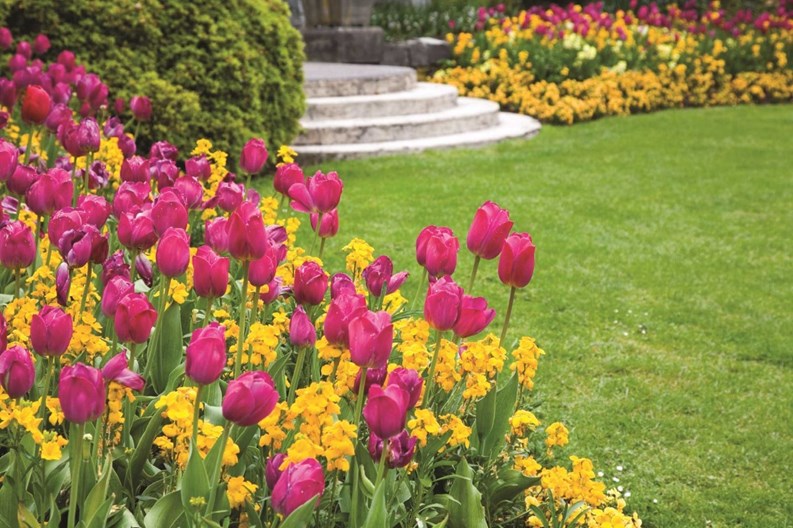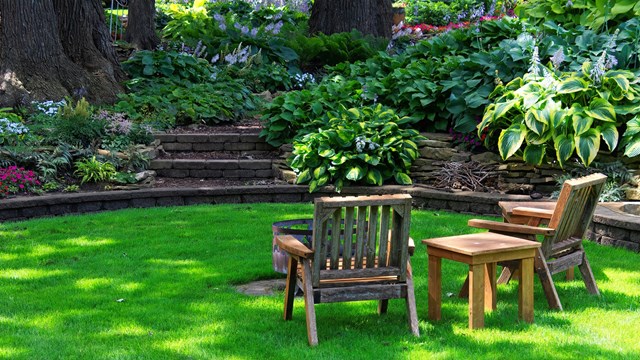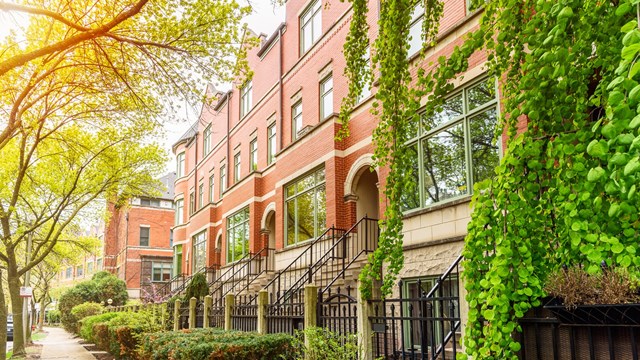Spring is here, which means the sky is blue, the grass is green, and the flowers will be blooming—that is, if you plant them. From knowing which plants do best in which location to keeping up with everyday care and maintenance, keeping your condo or co-op property looking nice can be hard work, but worth every minute and dime spent in the end. And with some extra knowledge from the inside, not only can properties uphold a high level of aesthetics, the endeavor can be cost-effective, even in this day in age.
The Right Plant in the Right Place
Plants are everywhere around us, but like everything else in the world, they have their time and place. It’s highly unlikely to see palm trees lining the streets of Chicago, and it would be a foolish board indeed who insisted that their landscaper plant any on their property. When it comes to deciding what kinds of flowers to plant on your own grounds or flowerbeds, it's vital to consider which species will flourish in the lakeside or inland environment, and which may not.
According to Greg Stack, a horticulture educator with the University of Illinois Extension, “We always start out by saying no matter what kind of plant a person picks, whether it be flowers or whatever, it has to be the right plant, in the right place. In other words, choose flowers that are going to do well in the location you've selected for your flower bed.”
“If it's a sunny border,” Stack continues, “plant sun-loving flowers. If it's a shaded area, plant flowers that thrive in the shade. If you reserve that just because you happen to like impatiens, for example, but you haven't got a shady spot for them, they aren't going to do very well, and you'll be disappointed. So always pick the plant that is best suited for the site—you'll be much happier, and the maintenance required will be much reduced.”
A Bouquet of Options
The two basic categories of flowering flora are perennials and annuals. Perennials are planted once and bloom again on their own season after season, whereas annuals die off after one growth cycle and must be replaced each year. According to Marianne Fons and Mark Davis, master gardeners who have undertaken a number of projects in both Central Iowa and Door County, Wisconsin, a balance of perennials and annuals is key to an attractive display of living blooms in your community's beds and planters.
“Because they bloom every year or every other year, and because many of them multiply on their own, perennial flowers are the backbone of a flower garden,” says Fons. “After the initial investment, all they require is time for maintenance, such as cutting back, fertilizing, and occasional watering during dry spells. If you have room for a climbing perennial, clematis is one of the prettiest. Other commonly seen perennials are asters, baby's breath, cone flowers, daisies, delphinium, peonies, and poppies.”
Stack says that the most popular flowers for Chicago-area buildings are impatiens, geraniums, petunias, and marigolds. “Because they are good, dependable performers. They give good value for the money people spend for them. There are a ton of other things people can select, of course, but they're less common—those are probably the top four.”
Fons adds that annuals—including petunias, marigolds, and pansies—which are purchased and planted each spring, “are beautiful, showy fillers to add to established perennials.” These flowers are usually sold in flats, and are generally less expensive than perennials. Replanting them every season may be a job, but it does allow for variety and different arrangements and color themes from year to year—and if you're lucky enough to have a landscaping committee or gardening club in your association, choosing and planting the new season's flowers is more of a pleasure than a chore.
Picking Flowers
Most gardeners and landscapers agree that there’s a hierarchy of considerations to account for in order to give your flowers the best chance for a long, beautiful life. It includes figuring out the best soil and optimal lighting conditions for your plants, their budget and maintenance schedules, and of course, your own community members' aesthetic preferences.
Though most flowers get planted in flowerbeds and decorative planters, your HOA certainly doesn't need to limit itself to just those kinds of arrangements. Window boxes, terraced landscaping elements, and hanging baskets are just a few of the other ways your building or association can incorporate live flowers into its visual program. An apartment complex is a blank canvas when it comes to vegetation, but again, everything has its place. You need to make sure that your flowers are planted in such a way that they get the appropriate amount of water, aren’t crowded, and get the right amount of sunlight. “When planting any flower, it's so important to read and follow instructions about spacing and sunlight,” says Davis. “If you don't follow the accompanying guidelines, you're wasting your investment.”
Knowing these guidelines doesn't necessarily take a degree in horticulture or a Master Gardener certificate. If your building or HOA prefers to put flower planting into the hands of a landscaping or gardening committee rather than a professional, you can certainly do so successfully—you just need to pay attention. “This advice goes for any type of planting whether flower, shrub, or tree,” says Fons, “and it's actually quite easy to follow. Every plant sold carries with it a tag indicating its mature size, as well as its light/shade requirements” and the ideal time to plant it.
“Comprehending mature size is also critical,” Fons continues. “Purchase and plant a pair of adorable little shrubs to each side of your building's front door without studying mature size and you may wind up featured in a what-not-to-do lecture on this topic. Once they reach maturity, those little shrubs can easily engulf the entire facade!”
Flowers aren't likely to engulf a building, but the advice holds—flowering climbing vines add bulk and foliage that must be maintained, and some otherwise lovely perennials may need vigorous trimming, so taking the time to research your options, read the information tags on your flora, and sketch out a scaled garden plan is time well spent.
Flower Maintenance
Once your flowers are in the ground, maintenance becomes the word of the day. Proper soil choice and mulching are key to successful flower cultivation, says Davis. “Refresh your mulch annually—usually in the spring,” he says. “Don't allow your flowerbed mulch-soil combination to become packed or moldy. You can refresh mulch materials by turning them with garden fork.”
“Proper watering, fertilizing, and grooming, like pinching or cutting back” are the main components of good flower bed maintenance, add Stack. “The only kind of flower that needs to be cared for in the off-season are the perennials because obviously the annuals die at the end of their blooming phase. You can clean up your perennial beds by removing the old stems and foliage, get the beds prepped, and if you have any plantings that are less tolerant of the cold, do some light mulching.
When it comes to what kinds of materials make for good mulch, “Cedar and cypress mulch are particularly good, though pricey,” says Davis. “Mulching with non-organic materials such as stone or rubber chips provides no nutrients, so they may not be the best investment.”
Davis also advises against what he calls 'volcano-style' mulching—i.e., mounding mulch close up against plant stems. “It's unhealthy for growing flora, it wastes mulch, and frankly, it just looks silly,” he says. “To mulch plantings properly, keep the ring of mulch six to 12 inches away from the stem, depending on size of the plant. The open area inside the mulch circle allows rainfall to reach the plant roots. In the general flower bed area, mulch helps control weeds, retains needed moisture, and creates pleasing aesthetics.”
In addition to mulch, when plants are first installed, they need a lot of water.
“Many people water their plants for 15 minutes and think that’s enough,” says one landscaper. “But you have to stick your fingers in the soil and see if it’s moist below the surface.”
Another mistake Stack sees in many flower beds is what he calls 'overplanting,' or putting flowers in too close to each other, which impedes their ability to grow—and inadequate or improper pre-planting preparation. “People often think they can just jam a plant in the ground and it's going to grow no matter what,” he says. “But you need to prepare the flower bed itself to accept flowers by working in ample organic matter, making sure the drainage is good, that sort of thing. Otherwise it's going to take heroic efforts to save your plants, and it's not going to work.”
Boards & Landscapers Working Together
Amid the ongoing recession and its accompanying housing slump, communities are definitely cutting back on their landscaping budgets—especially when it comes to short-term, high-cost elements like annual flowers which have to be replaced each year.
“Perennials are the way to go when on a budget,” says one landscaper. “You can put ten new plants in a year, and eventually you’ll end up with a really nice garden.”
Some HOAs are consolidating and finding ways to streamline their flower planting strategy. For instance, instead of having 30 small flowerbeds littered around, Fons says an association might consider cutting down to 12 beds, but make them slightly bigger. Additionally, they can make better use of any space that is available, and can look to reputable professionals for opinions to get the most impact out of their displays.
As with any building or complex-wide improvement plan, a board or committee looking to upgrade, overhaul, or just freshen up their community's flower plantings has to be clear—both to themselves and to their landscaping or gardening professional - about their expectations and budgetary constraints. The best option is to seek out competing bids, check references of individual firms, make sure that all the specifications are met for the contract and that the board ends up satisfied with how the community looks.
After regular maintenance expenses, landscaping is frequently the biggest yearly budget item for condos and co-ops—but it's one that pays for itself in both enjoyment and improved property values. “Flowers just make a place special,” says Stack. “Whether it's the home level, the municipal level, or the commercial level, flowers tell a person that someone here cares, and that this is a special place.”
Bernadette Marciniak is a freelance writer and a frequent contributor to The Chicagoland Cooperator. Associate Editor Hannah Fons contributed to this article.







Leave a Comment